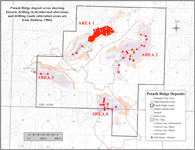During the 1970s, development of the Blawn Mountain project was significantly advanced by a joint venture between Southwire Company ("Southwire"), National Steel Corporation ("National Steel") and Earth Sciences Inc. ("Earth Sciences"). The primary objective of the joint venture partners was to develop the project as a domestic source of alumina, with the bulk of production supplying the National-Southwire alumina smelter in Kentucky. At that time, and today, virtually all alumina production in the United States is derived from imported bauxite. By the early 1980s, the project had lost momentum as a collapse in alumina prices and economic conditions made financing difficult.
In April 2011, SOPerior Fertilizer Corp. gained ownership of all the historical data related to the prior development of the alunite project located in the Blawn Mountain project area. The following historical development work was completed during the 1970s:
-
Exploration and Drilling – Geological mapping and surface sampling identified four principal areas of strong alunite mineralization and 320 holes were previously drilled by Earth Sciences, with most of the drilling focused on Area 1, where the best reserves with respect to grade of alunite and mining conditions appeared to exist. A non-compliant NI 43-101 resource estimate was calculated. The historical resource estimates relating to the former alunite property relied on by SOPerior Fertilizer Corp. for the Blawn Mountain Project may not be accurate and are difficult to relate to current resource assessments primarily due to the focus of past programs on alumina production with potash as a secondary product. Historical cut-off grades were based on Al2O3
content and therefore they will not be reflective of the K2O estimates that SOPerior Fertilizer Corp. will use since potassium was not optimized.
 |
| click to enlarge |
- Environmental Studies – Detailed environmental studies were carried out and an Environmental Impact Statement was submitted. The Final Environmental Impact Statement led to the issuance of potassium leases in February 1983 by the Bureau of Land Management.
- Pilot Plant – Hazen Research conducted extensive metallurgical work and conducted bench testing whereby 11 tonnes per day of alunite from Area 1 was processed at a pilot plant based in Golden, Colorado. The pilot plant incorporated alunite roasting technology acquired from the Soviet Union based on a pre-existing commercially operated alunite processing plant in Azerbaijan.
- Mine Plan – A mine plan was prepared for the first 25 years of projected operation in 1975. The focus of the mine plan was the Northern Part of Area 1 where most of the drilling occurred.
- Feasibility Study and Permitting – A non-compliant 43-101 feasibility study was completed for an alunite processing complex that was to be situated near Area 1.